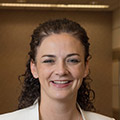Elizabeth Cosgriff-Hernández, Ph.D., Professor, Department of Biomedical Engineering, The University of Texas at Austin
Abstract: Tissues have evolved to have complex function derived from the hierarchical structure of the tissue, from protein sequence to macroscale architecture. Achieving this level of structural complexity and function with synthetic materials continues to be challenging. Rather than attempting to fully replicate the complexity of tissue structures, identification of which structure-property relationships drive clinical success can be used to better inform biomaterial design. Polymer chemistry and engineering can then be used to target specific biomaterial design criteria expected to improve clinical outcomes. As a representative example, a major roadblock in off-the-shelf vascular graft development is achieving rapid endothelialization of the lumen while minimizing the risk of thrombosis, intimal hyperplasia, and mechanical failure. However, matrix properties which promote graft endothelialization may not be consistent with those appropriate to sustain the loads associated with adult vasculature. To address this limitation, we have developed multilayered hydrogel-electrospun mesh scaffolds in which a hydrogel layer provides a local microenvironment inductive of rapid endothelialization and an electrospun mesh sleeve provides bulk strength, compliance matching, and suture retention. Thus, each component can be individually tuned to achieve improved outcomes without detriment to other design goals and then bonded together into composite grafts. The design criteria for the electrospun mesh was based on the strong empirical evidence that a graft that more closely matches native arterial compliance can improve the long-term clinical success of synthetic vascular grafts by preventing flow disruption and the stimuli for intimal hyperplasia. Overall, the selective mimicking of the native arterial structure generated a multi-layer graft design with strong potential for long-term patency in small diameter applications (i.e., coronary artery bypass grafts). Our laboratory utilizes this approach to address several critical areas in regenerative engineering including 3D printed bone grafts with integrin-mediated osteogenesis, chronic wound dressings, and gradient tendon-to-bone grafts.
Biography: Elizabeth Cosgriff-Hernández, Ph.D. is a Professor of Biomedical Engineering at The University of Texas at Austin and holder of the Cullen Trust for Higher Education Endowed Professorship in Engineering. She received a B.S. in Biomedical Engineering and Ph.D. in Macromolecular Science and Engineering from Case Western Reserve University under the guidance of Professors Anne Hiltner and Jim Anderson. She then completed a UT-TORCH Postdoctoral Fellowship with Professor Tony Mikos at Rice University with a focus in orthopaedic tissue engineering. Dr. Cosgriff-Hernandez joined the faculty of the Biomedical Engineering Department at Texas A&M University in 2007 prior to moving to The University of Texas at Austin in 2017. Her laboratory specializes in the design of novel biomaterials to address current clinical failures of medical devices and therapies. She also serves on the scientific advisory board of ECM Biosurgery and as a consultant to several companies on biostability evaluation of medical devices. Dr. Cosgriff-Hernandez is an Associate Editor of the Journal of Materials Chemistry B and Fellow of the International Union of Societies for Biomaterials Science and Engineering, the Biomedical Engineering Society, the American Institute for Medical and Biological Engineering, and the Royal Society of Chemistry. She has previously served as an Associate Editor of the Journal of Biomedical Materials Research, Part B and chair of the NIH study section on Musculoskeletal Tissue Engineering.










.jpg)
.jpg)
.jpg)

.jpg)
